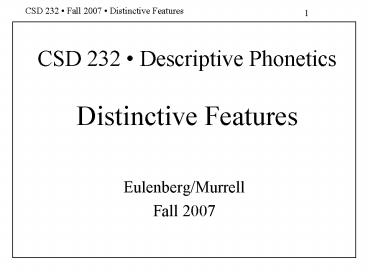CSD 232 - PowerPoint PPT Presentation
1 / 24
Title:
CSD 232
Description:
... / p / = voiceless bilabial stop Distinctive Features /p / described as a bundle of features Distinctive Feature Theory Roman ... t/ writing / re] 8a / /t ... – PowerPoint PPT presentation
Number of Views:86
Avg rating:3.0/5.0
Title: CSD 232
1
CSD 232 Descriptive PhoneticsDistinctive
Features
- Eulenberg/Murrell
- Fall 2007
2
Phonological Analysis
- A Phonological Analysis consists of the following
elements - List of the phonemes of a language
- Classification system for categorizing the
phonemes - Phonotactics - positional and sequential
occurrences of phonemes within a language - List of the allophonic variations for each of the
phonemes
3
Alternative Classification SystemsFor Describing
and Categorizing Phonemes
- Classical phonetic features of place and manner,
and voicing - Distinctive Features
4
Classical Phonetic Features
- /p / specified using articulatory
descriptors - / p /
- voiceless bilabial stop
5
Distinctive Features
- /p / described as a bundle of features
- -Vocalic
- Consonantal
- -Sonorant
- -Coronal
- Anterior
- -High
- - Low
- - Back
- - Rounded
- - Distributed
- - Nasal
- - Lateral
- - Continuant
- Tense
- - Voiced
- -Strident
6
Distinctive Feature Theory
- Roman Jakobson
- Prague School of Linguistics (Pre-WWII)
- Massachusetts Institute of Technology (MIT) and
Harvard University - Gunnar Fant
- KTH - Royal Technical Institute, Stockholm,
Sweden - Morris Halle
- Masschusetts Institute of Technology
7
Uses for Distinctive Features
- To specify a phoneme
- To specify a class of phonemes
- To describe the set of speech sounds used in a
particular language or dialect - To write concise rules of phonetic change
- To characterize a speech disorder
- e.g. substitution, often involving a change of
feature)
8
Distinctive Features
- Features are binary ( or - values)
- Each speech sound may be described as a bundle
of features - Each member of every pair of phones is
distinguished from the other member by at least
one feature value - Features are universal, but a given language may
use a subset of features as distinctive
9
Features(Original Jakobson, Fant Halle
features)
- Vocalic/Nonvocalic
- Consonantal/Nonconsonantal
- Sonorant/Obstruent
- Rhotic/Nonrhotic (vowels)
- Advanced/Nonadvanced (vowels and diphthongs)
- Front/Nonfront (vowels)
- Coronal/Noncoronal Acute/Grave
- Anterior/Nonanterior Compact/Diffuse
(consonants)
10
Features, continued (Original Jakobson, Fant
Halle features)
- High/Nonhigh
- Low/Nonlow
- Back/Nonback
11
Features, continued (Original Jakobson, Fant
Halle features)
- Rounded/Nonrounded (Flat/Plain)
- Distributed/Nondistributed
- Nasal/nonnasal
- Lateral/Nonlateral
12
Features, concluded(Original Jakobson, Fant
Halle features)
- Continuant/Stop
- Tense/lax (vowels)
- Voiced/voiceless
- Strident/Nonstrident (consonants)
13
Redundancy Rules
- All vowels in English are Voiced
- All -Voiced sounds are Consonantal,
-Nasal, -Sonorant and -Vocalic - Anterior sounds are -Distributed
- Sounds that are both -Continuant and
Anterior are -Strident - -Coronal sounds are -Lateral
14
With Redundancy eliminated
-Voiced -Continuant Anterior -Coronal
/p/
15
Features Used to Define A Class
- Class of Stop Consonants
- /p,b,t,d,k,g/
Consonantal -Vocalic -Continuant -Nasal
-Distributed
16
Concept of Complement
A is the complement of B
B is the complement of A
B
A
A complements B. A B whole
17
Complementary Distribution
- aspirated /p/ in syllable initial position pot
- p(et
- non-aspirated after /s/ spot
- sp)et
18
Free Variation
- cigarette - stress on first or last syllable
- economics - first vowel sound /i/ or /2/
- aspiration of final /p/ in pop
19
Phonotactic Rules
- Some languages permit only CV syllables
- English has consonant clusters sixths
- Some languages permit engma a as first sound in
a word - If a word starts with three consonants, the first
must be /s/
20
Levels of Structure
- Phone
- Phoneme
- Morpheme
- Word
- Phrase
- Sentence
- Paragraph
21
Phonological Rules
- Sound Changes
- Example
- write /ret/
- writing / reú8a /
- /t/ becomes /ú/ when it occurs between a
preceding vowel and a following non-stressed vowel
22
Using Distinctive Features To Indicate A Sound
Change Rule
/
- -Voiced
Voiced
?
Coronal Anterior --------- -Continuant -Nasal
Vocalic -Consonantal
Vocalic -Consonantal -Stress
23
Example of a Substitution Rule
/c/ ? /s/
A common substitution made by children shoe
pronounced as Sue
24
Feature Representation of Rule































